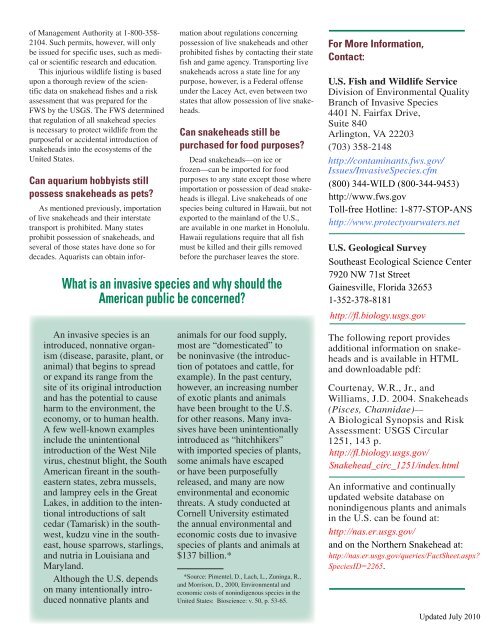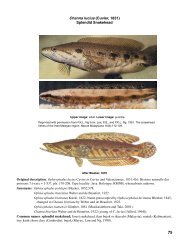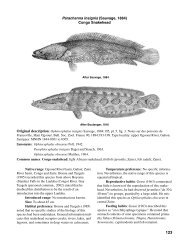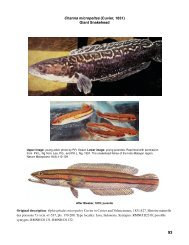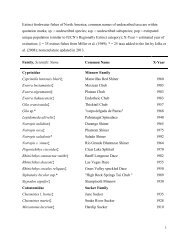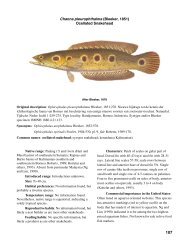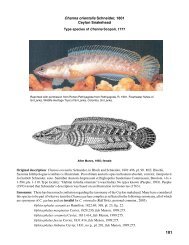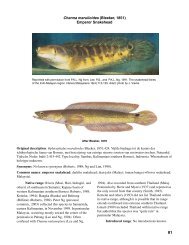Invasive Species ProgramâSnakeheads, Aquatic Invaders
Invasive Species ProgramâSnakeheads, Aquatic Invaders
Invasive Species ProgramâSnakeheads, Aquatic Invaders
Create successful ePaper yourself
Turn your PDF publications into a flip-book with our unique Google optimized e-Paper software.
of Management Authority at 1-800-358-<br />
2104. Such permits, however, will only<br />
be issued for specific uses, such as medical<br />
or scientific research and education.<br />
This injurious wildlife listing is based<br />
upon a thorough review of the scientific<br />
data on snakehead fishes and a risk<br />
assessment that was prepared for the<br />
FWS by the USGS. The FWS determined<br />
that regulation of all snakehead species<br />
is necessary to protect wildlife from the<br />
purposeful or accidental introduction of<br />
snakeheads into the ecosystems of the<br />
United States.<br />
Can aquarium hobbyists still<br />
possess snakeheads as pets<br />
As mentioned previously, importation<br />
of live snakeheads and their interstate<br />
transport is prohibited. Many states<br />
prohibit possession of snakeheads, and<br />
several of those states have done so for<br />
decades. Aquarists can obtain information<br />
about regulations concerning<br />
possession of live snakeheads and other<br />
prohibited fishes by contacting their state<br />
fish and game agency. Transporting live<br />
snakeheads across a state line for any<br />
purpose, however, is a Federal offense<br />
under the Lacey Act, even between two<br />
states that allow possession of live snakeheads.<br />
Can snakeheads still be<br />
purchased for food purposes<br />
Dead snakeheads––on ice or<br />
frozen––can be imported for food<br />
purposes to any state except those where<br />
importation or possession of dead snakeheads<br />
is illegal. Live snakeheads of one<br />
species being cultured in Hawaii, but not<br />
exported to the mainland of the U.S.,<br />
are available in one market in Honolulu.<br />
Hawaii regulations require that all fish<br />
must be killed and their gills removed<br />
before the purchaser leaves the store.<br />
What is an invasive species and why should the<br />
American public be concerned<br />
For More Information,<br />
Contact:<br />
U.S. Fish and Wildlife Service<br />
Division of Environmental Quality<br />
Branch of <strong>Invasive</strong> <strong>Species</strong><br />
4401 N. Fairfax Drive,<br />
Suite 840<br />
Arlington, VA 22203<br />
(703) 358-2148<br />
http://contaminants.fws.gov/<br />
Issues/<strong>Invasive</strong><strong>Species</strong>.cfm<br />
(800) 344-WILD (800-344-9453)<br />
http://www.fws.gov<br />
Toll-free Hotline: 1-877-STOP-ANS<br />
http://www.protectyourwaters.net<br />
U.S. Geological Survey<br />
Southeast Ecological Science Center<br />
7920 NW 71st Street<br />
Gainesville, Florida 32653<br />
1352-378-8181<br />
http://fl.biology.usgs.gov<br />
An invasive species is an<br />
introduced, nonnative organism<br />
(disease, parasite, plant, or<br />
animal) that begins to spread<br />
or expand its range from the<br />
site of its original introduction<br />
and has the potential to cause<br />
harm to the environment, the<br />
economy, or to human health.<br />
A few well-known examples<br />
include the unintentional<br />
introduction of the West Nile<br />
virus, chestnut blight, the South<br />
American fireant in the southeastern<br />
states, zebra mussels,<br />
and lamprey eels in the Great<br />
Lakes, in addition to the intentional<br />
introductions of salt<br />
cedar (Tamarisk) in the southwest,<br />
kudzu vine in the southeast,<br />
house sparrows, starlings,<br />
and nutria in Louisiana and<br />
Maryland.<br />
Although the U.S. depends<br />
on many intentionally introduced<br />
nonnative plants and<br />
animals for our food supply,<br />
most are “domesticated” to<br />
be noninvasive (the introduction<br />
of potatoes and cattle, for<br />
example). In the past century,<br />
however, an increasing number<br />
of exotic plants and animals<br />
have been brought to the U.S.<br />
for other reasons. Many invasives<br />
have been unintentionally<br />
introduced as “hitchhikers”<br />
with imported species of plants,<br />
some animals have escaped<br />
or have been purposefully<br />
released, and many are now<br />
environmental and economic<br />
threats. A study conducted at<br />
Cornell University estimated<br />
the annual environmental and<br />
economic costs due to invasive<br />
species of plants and animals at<br />
$137 billion.*<br />
*Source: Pimentel, D., Lach, L., Zuninga, R.,<br />
and Morrison, D., 2000, Environmental and<br />
economic costs of nonindigenous species in the<br />
United States: Bioscience: v. 50, p. 53-65.<br />
The following report provides<br />
additional information on snakeheads<br />
and is available in HTML<br />
and downloadable pdf:<br />
Courtenay, W.R., Jr., and<br />
Williams, J.D. 2004. Snakeheads<br />
(Pisces, Channidae)––<br />
A Biological Synopsis and Risk<br />
Assessment: USGS Circular<br />
1251, 143 p.<br />
http://fl.biology.usgs.gov/<br />
Snakehead_circ_1251/index.html<br />
An informative and continually<br />
updated website database on<br />
nonindigenous plants and animals<br />
in the U.S. can be found at:<br />
http://nas.er.usgs.gov/<br />
and on the Northern Snakehead at:<br />
http://nas.er.usgs.gov/queries/FactSheet.aspx<br />
<strong>Species</strong>ID=2265.<br />
Updated July 2010


